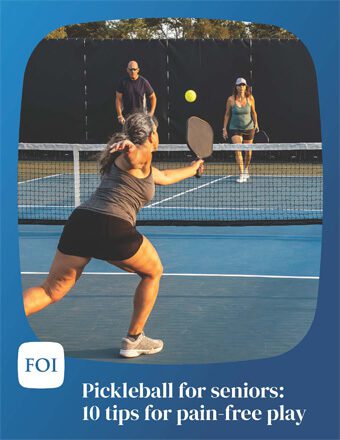Shoulder impingement
Shoulder injuries are often debilitating and potentially life-inhibiting. One specific problem is called swimmer’s shoulder, or thrower’s shoulder, which is medically is known as shoulder impingement syndrome.
Shoulder impingement is one of the most common reason adults have shoulder pain. It occurs when certain structures of the shoulder–particularly the soft tissues of the rotator cuff and the lubricating sack (subacromial bursa) between the rotator cuff and the underside of the bone that is the top part of the shoulder (acromion)–within the shoulder are irritated or “pinched.” When it becomes a chronic condition, a patient is diagnosed with shoulder impingement syndrome. This syndrome may be accompanied by shoulder tendonitis and bursitis.
Anatomy

Your shoulders are complex structures made up of several key parts. Two such features are the shoulder blade and the rotator cuff. Thrower’s or swimmer’s shoulder occurs when the shoulder blade’s outer region repeatedly makes contact with the rotator cuff. Scientifically, this abnormal occurrence is referred to as impingement, hence the name shoulder impingement syndrome.
About
As shoulder impingement progresses, the constant pressure causes the rotator cuff to experience increasing levels of irritation and damage, which eventually leads to many unpleasant and possibly debilitating symptoms.
Causes
Shoulder impingement often results from several possible causes, including a congenital shoulder blade flaw, bone spurs, bursitis, and soft tissue damage.
The part of the shoulder blade responsible for causing impingement is a bone-like structure called the acromion. Some are people born with this structure unusually shaped instead of flat. The acromion rubs against surrounding bones, muscles, and soft tissues in such cases.
As you age, you are at greater risk for developing a condition known as bone spurs. These growths are sharp edges typically developing where bones and joints meet. Should this occur in your shoulder blade, your risk of shoulder impingement syndrome dramatically increases.
Your shoulder contains many liquid-filled sacs called bursa. They are located between the shoulder blade and surrounding soft tissues like tendons. When they become inflamed or irritated, a condition called bursitis occurs, and impingement can result.
Should nearby soft tissues like tendons become damaged or torn, shoulder impingement syndrome can occur.
This condition is commonly caused by overuse and can affect young people as well as older adults. Athletes who participate in sports that have repetitive overhead movements, such as swimmers, pitchers and tennis players, are susceptible to shoulder impingement. Also, adults who perform repetitive movements, such as lifting or overhead activities like weightlifting, painting, wallpaper hanging or construction work, can develop the problem.
Learn how to avoid shoulder impingement and other conditions that cause pickleball shoulder pain.
Risk factors
Your risk is significantly increased if you take part in sports requiring repeated throwing motions or intense shoulder movement. Specific sports include:
- Baseball pitching
- Swimming
- Tennis
- Volleyball
- Weightlifting
If your job requires constant shoulder movements like painting, carpentry, and window washing, your chances of developing shoulder impingement syndrome increase.
Natural age-related shoulder structure deterioration can also result in shoulder impingement syndrome.
Moreover, the condition could occur following events capable of causing serious and acute shoulder trauma such as falls and car accidents.

Symptoms
The most clear-cut symptom of shoulder impingement syndrome is pain. This discomfort can:
- Worsen when you lift your arms or weighty objects
- Travel from your shoulder’s frontal region to your arm’s side
- Intensify during the night and interfere with your ability to sleep
- Is more noticeable when you lie on the affected shoulder
You might have redness, tenderness, or swelling in the injured shoulder, and increasing stiffness or weakness, making routine activities, or even moving your shoulder difficult.
Usually, symptoms develop over a period ranging anywhere from a couple of weeks to several months.
Shoulder impingement syndrome symptoms may include:
- Pain and discomfort in the shoulder that is present both at rest and with activity, particularly when performing movements that require the arms to move above shoulder level. Often the pain is sudden with lifting and reaching movements, and sometimes the pain radiates from the front of the shoulder to the side of the arm.
- Mild to moderate weakness, especially worse with overhead activity.
- Local swelling and tenderness in the front of the shoulder.
- Mild popping or crackling sensations in the shoulder.
- Possible numbness or tingling in the hands.
- Trouble finding a comfortable position for sleep.
Complications
If not given proper medical attention, shoulder impingement syndrome will more than likely worsen, resulting in severe pain, mobility problems, and potentially even permanent shoulder damage. Shoulder impingement syndrome could also increase your risk of more serious injuries such as tears to your rotator cuff and biceps muscle tendon.
Diagnosis
Typically, your doctor or orthopedic specialist will begin an evaluation by asking you several important questions such as:
- If you are physically active
- The specific sports or activities you take part in
- If your job requires continual shoulder movements
- When your shoulder pain started
- If any actions or movements worsen your discomfort
Should your doctor suspect shoulder impingement syndrome, they will likely perform a complete visual examination of the shoulder. During this diagnosis phase, they will pay close attention to any redness or swelling found in your shoulder region.
After visual evaluation, your doctor may test your shoulder’s strength and mobility.
If they cannot reach a firm conclusion or wish to rule out conditions causing similar symptoms, they may order internal imaging tests such as X-rays and MRI scans (magnetic resonance imaging).
Treatment
Treatment often centers on identifying and correcting the impingement’s underlying cause while helping you regain full function of the affected shoulder. In a large percentage of cases, improvement occurs following nonsurgical therapy. The most serious cases or those not responding to traditional treatment efforts may need surgery.
Nonsurgical treatments
Mild to relatively moderate incidents often respond to significant periods of rest. This inactivity allows your shoulder to heal. Moreover, the application of ice packs is also often effective in reducing swelling or redness.
If you experience noticeable pain or discomfort interferes with your ability to perform even the most basic activities, over-the-counter pain-relievers and anti-inflammatory medications can prove beneficial.
More moderate or particularly painful cases may need steroid injections. These powerful drugs can quickly reduce inflammation and promote healing.
Regardless of your case’s severity, you will likely need to undergo a course of physical therapy. PT, commonly abbreviated and referred to, is a collection of exercises trained physical therapists design specifically for you with your doctor’s input. PT exercises are geared towards restrengthening your shoulder and recapturing lost motion ranges.
The initial and preferred treatment for shoulder impingement syndrome is non-surgical alternatives. They might include:
- Rest and avoidance of overhead and repetitive activities.
- Oral anti-inflammatory medications.
- Cold therapy.
- Ultrasound therapy to stimulate the tissues and improve blood flow.
- Physical therapy, including stretching and strengthening exercises.
- Steroid/cortisone injection.
Surgical procedures
The most serious cases or those not responding to the previously mentioned treatments may need surgery.
One such surgery removes a part of the shoulder blade to create more room for the rotator cuff. This operation is called an arthroscopic shoulder decompression. It is performed using a minimally invasive piece of equipment called an arthroscope.
Severe cases of shoulder impingement syndrome or those that led to other shoulder injuries might need open surgery, requiring larger incisions.
If, after several weeks to several months, the non-surgical treatment options don’t help, an orthopaedic surgeon may recommend surgery. The goal of surgery for this syndrome is to remove the impingement and create more space for the rotator cuff. This allows the ball on the end of the upper arm bone to move freely so the arm can be lifted without pain. This form of surgery is called subacromial decompression or anterior acromioplasty.
Depending upon the surgeon’s preference and the injury, the surgery may take one of two forms: open or arthroscopic.
- Open surgical repair requires a small incision in the front of the shoulder. In most cases, the front edge of the acromion is removed along with some of the bursal tissue to create space.
- Arthroscopic repair makes use of a fiberoptic scope connected to a video camera and small, specialized instruments. The scope and instruments are inserted into small puncture-type incisions rather than through a larger, open incision. The surgeon then removes bone and soft tissue.
The arm may be immobilized after surgery for the initial healing process. Soon after, a physical rehabilitation program will be used to regain range of motion and strength in the shoulder and arm. It may take several months to rehabilitate the shoulder and have pain subside.
Prognosis
Researchers have found that non-surgical treatments typically produce favorable results in as many as 60% of those diagnosed with shoulder impingement syndrome. Recovery typically occurs over a period of weeks to months. Surgical procedures are also usually very effective. Recovery times will vary depending on many underlying factors.

Pickleball for seniors: 10 tips for pain-free play
Videos
Related specialties
- AC Joint Injuries
- Atraumatic Shoulder Instability
- Bankart Repair
- Bicep Tenodesis
- Broken Collarbone
- Bursitis of the Shoulder (Subacromial Bursitis)
- Calcific Tendinitis of the Shoulder
- Clavicle Fractures
- Dislocated Shoulder
- Fractures of the Shoulder Blade (Scapula)
- Glenoid Labrum Tear
- Little League Shoulder
- Reverse Total Shoulder Replacement
- Rheumatoid Arthritis (RA) of the Shoulder
- Rotator Cuff Tears
- Shoulder Arthritis
- Shoulder Arthroscopy
- Shoulder Injury: Pain in the Overhead Athlete
- Shoulder Replacement
- Shoulder Separations
- Shoulder Socket Fracture (Glenoid Fracture)
- SLAP Tears & Repairs
- Subacromial Decompression
- Trapezius Strain (Muscle Strain Of The Upper Back)
- Traumatic Shoulder Instability
